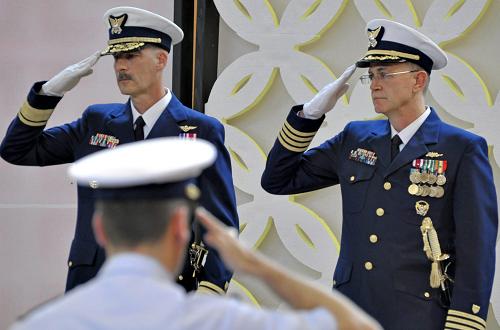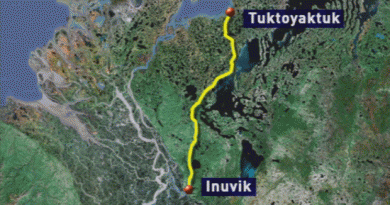U.S. Coast Guard outlines plans for western Alaska

Coast Guard Admiral Thomas Ostebo visited Nome last week to outline summer plans for Western Alaska. The plans are part of the Coast Guard’s Alaska operation for the year, officially titled Arctic Shield 2014.
Nome should expect a regular stream of Coast Guard ships pulling in for supplies, fuel, and crew changes.
Expected vessels include buoy tenders and cutters, particularly the Alex Haley.
In Barrow the Coast Guard will station a buoy tender and a national security cutter offshore. Also, they will open an emergency response helicopter facility to aid industries and communities in the North Slope.
If Shell Oil Company receives its drilling permits for the Chuckchi Sea, a Coast Guard ship will remain on the drill site at all times.
In Kotzebue the Coast Guard will use the air facility on an as-needed basis for deployment and crew swaps. In Point Clarence, the Coast Guard will port a patrol boat to monitor the Bering waters, respond to offshore incidents, and aid local vessel boardings.
In addition, the Coast Guard will conduct disaster and oil spill response training in communities along the Western coast.
“So you can expect to see a lot of Coast Guard folks again,” Ostebo said. “Hopefully that’s a good thing.”
While in past years, the Coast Guard focused either on the Arctic or on Alaska’s western coast, Ostebo says, this summer the Coast Guard will be patrolling both areas.
“Next summer we’re going to have to try to keep our foot in both places, because the threat remains in both places,” Ostebo said.
That threat stems from potential accidents like vessel collisions, oil spills, and situations requiring search and rescue. Ostebo’s top concern is the unregulated increase of vessels through the Bering Strait. This traffic overshadows even the risks associated with oil and gas extraction. Last year, Ostebo says, the Bering Strait saw the highest number of ship and cargo passage in the strait’s history, and the Coast Guard expects an even higher rate this year.
“When we have as much of the increase in traffic as we’re seeing take place in the Bering Strait, two ships colliding with each other, a ship running aground on Little Diamede, a ship losing power or having a fire, or those kinds of things are really the biggest concerns that I have as I look to the threats in this area and the CG needs to be here to support that,” Ostebo said.
Ostebo says the Coast Guard and its Russian counterpart are drafting voluntary regulations for vessel routing and reporting through the strait.



